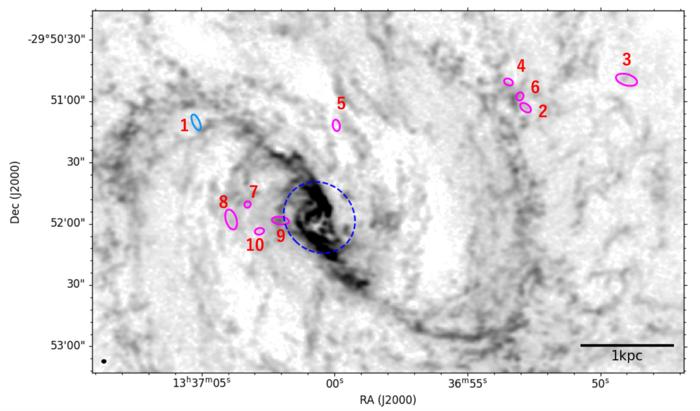Researchers have recently made a significant discovery concerning high-velocity clouds (HVCs) within the nearby spiral galaxy M83. These clouds exhibit velocities that are markedly distinct from the overall rotation speed of the galaxy. Such revelations have profound implications, suggesting that these gas clouds may have originated from outside the galaxy. This breakthrough offers fresh perspectives on how galaxies acquire the necessary materials for star formation over extensive astronomical timescales.
The study, led by Maki Nagata and a team of astronomers from the University of Tokyo, tackled a fundamental question that has long perplexed astronomers: How do galaxies sustain star formation over billions of years? Despite predictions that star formation in a galaxy like our Milky Way should come to a halt within a billion years, observations show that it continues unabated. This ongoing activity implies that galaxies must regularly obtain additional sources of matter, motivating Nagata and her colleagues to investigate these potential contributors.
Gas clouds are a ubiquitous component of many galaxies, and among them are high-velocity clouds (HVCs). Researchers have hypothesized that these clouds could play a crucial role in the galactic feeding process. HVCs are characterized by their unusual speeds and trajectories, which do not align with the common rotational patterns typical of a spiral galaxy. The unique dynamical behavior of these clouds raised questions about their origins. One prevailing theory suggested that HVCs might be remnants from supernova explosions, but Nagata’s team aimed to apply advanced analytical techniques to determine if at least some of these clouds originated beyond M83.
The task of identifying and confirming the existence of HVCs proved to be a significant challenge for the research team. Accurate detection depended heavily on fine-tuning detection parameters to isolate genuine signals from competing background noise. This meticulous process was crucial to ensure that valid signals indicating HVCs were not overlooked amid potential false detections. The team defined high-velocity clouds as those moving at least 50 kilometers per second faster or slower than the rotation of the galactic disk. Their calculations yielded a set of ten clouds that satisfied these criteria, among which only one cloud aligned with a known supernova remnant, while the remaining nine could not be readily attributed to supernova events or local galactic phenomena.
The kinetic energy possessed by these remaining clouds surpassed expectations for supernova ejecta, further supporting their potential origin from outside the galaxy. This finding reinforced the hypothesis that these high-velocity clouds may be falling toward M83, a process that could signify that galaxies are not isolated entities but rather engage in a dynamic relationship with their cosmic surroundings. This interaction presents evidence that galaxies can grow by accreting gas from intergalactic spaces, possibly drawn in from smaller galactic neighbors or the diffuse intergalactic medium.
One particularly surprising aspect of the study was the composition of the high-velocity clouds. While HVCs are typically regarded as low-density atomic hydrogen gas, Nagata’s research uncovered that these clouds were unusually compact, consisting predominantly of dense molecular gas. This type of gas is crucial for the formation of new stars, suggesting that the incoming material from these clouds could have immediate implications for star formation within M83. Not only could HVCs be feeding the galaxy with essential materials, but they may also directly contribute to the process of star formation, shaping the future of the galaxy.
As M83 bears similarities to the Milky Way, the implications of this research extend to our understanding of our galaxy’s own evolution. By examining how high-velocity clouds influence star formation in M83, Insights may also be gleaned concerning the Milky Way’s past and future star formation activities. While HVCs were initially discovered within our galaxy, measuring fundamental properties such as their distances, masses, and movements has presented obstacles, thus necessitating the study of a nearby galaxy where these measurements could be more accurately assessed.
Moving forward, the research team plans to delve deeper into the formation processes of these molecular high-velocity clouds. One area of inquiry will focus on whether these clouds originated as atomic gas, and if so, the mechanisms leading to their transformation. The investigation will also aim to assess the clouds’ relationships with other gas structures, such as neutral atomic hydrogen, to uncover how these dynamics interplay within a galactic context. An additional objective is to examine the potential for these infalling clouds to trigger new star formation by colliding with the galaxy’s disk.
Such explorations could ultimately help the team answer the pivotal questions posed at the beginning of the study regarding the sustainability of star formation over billions of years. With the insights gained from M83, researchers hope to illuminate relevant aspects of not only M83’s own trajectory but also that of our home galaxy, the Milky Way. As this area of research progresses, it promises to enhance our grasp of the intricate processes that govern galactic evolution and the universe’s larger narrative.
In summary, the discovery of high-velocity clouds within M83 marks an important advancement in our understanding of galactic dynamics. This research emphasizes the intricate relationship between galaxies and their environments, presenting a more nuanced view of how galaxies grow and sustain star formation over vast epochs of cosmic time. As astronomers like Maki Nagata continue their investigations, we can expect further revelations that may clarify the enigmas surrounding galactic formation and evolution.
Subject of Research: High-Velocity Molecular Clouds
Article Title: High-Velocity Molecular Clouds in M83
News Publication Date: 30-Jun-2025
Web References: N/A
References: N/A
Image Credits: ©2025 Nagata et al. CC-BY-ND
Keywords
High-velocity clouds, M83, star formation, astronomy, galactic dynamics, molecular gas, intergalactic medium, supernovae, astrophysics.




